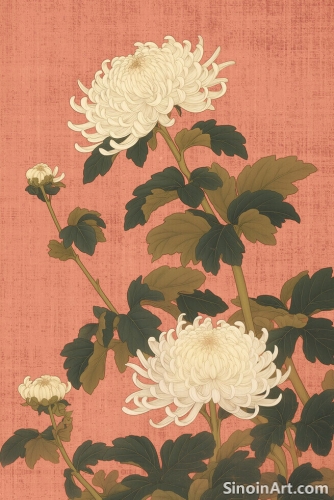The Use of Texture in Gongbi Painting
|
While Gongbi painting is often associated with smooth surfaces and precise linework, artists also employ subtle techniques to suggest texture and depth in their work. These techniques, ranging from layering washes to stippling effects, add a dimension to the work that helps create realism and visual interest in the painted surface. The suggestion of texture enhances the overall visual impact of the piece.  The layering of color washes, a fundamental technique in Gongbi, can also create a subtle sense of texture. By applying multiple layers of translucent washes, artists can create a layered surface that gives both depth and texture to the painting. The subtle differences in the layers help to add realism and surface complexity.  The use of ink wash variations, where different densities of ink are applied to paper, is another important way to suggest texture in Gongbi painting. Lightly applied ink creates a smooth surface, while darker areas give the impression of a rougher texture. The use of varied ink washes allows the artist to suggest different textures.  Specific brushstroke techniques, like stippling or hatching, can also be used to simulate the appearance of different textures, such as the roughness of tree bark or the softness of fabric. The use of specific brushstrokes in these areas further enhances the sense of reality within the work. The subtle variations in surface texture help to enhance the overall sense of depth and realism in Gongbi painting. These techniques add subtle details that enhance the overall impact of the work. The integration of texture into Gongbi painting demonstrates the artist's command of technique and their keen understanding of the visual world, creating works that are both technically precise and visually compelling. The suggestion of texture adds to the overall visual impact of the work. |
Tag : Texture in art, Gongbi techniques, surface in painting, visual realism, art layering
Related information
- The Use of Gold Leaf in Gongbi: Adding a Touch of Opulence
- The Conservation and Care of Gongbi Paintings
- Famous Gongbi Artists: Masters of the Brush
- Gongbi Painting and its Role in Cultural Diplomacy
- The Materials of Gongbi: A Closer Look at Tools and Pigments
Discusses the use of gold leaf in Gongbi painting, its application techniques, symbolism, and contribution to the opulence and visual impact of the art.
This article provides essential information on the conservation and care of Gongbi paintings, including controlling the environment, proper storage, framing techniques, cleaning recommendations, and the importance of regular inspections to ensure the longevity of these delicate artworks.
A profile of influential Gongbi artists throughout history, highlighting their contributions and styles.
This article explores the role of Gongbi painting in cultural diplomacy, highlighting its ability to foster cross-cultural understanding, promote artistic collaboration, and serve as a symbol of Chinese cultural identity on the global stage.
This article provides a detailed overview of the materials used in Gongbi painting, including rice paper, Chinese brushes, inksticks, and natural mineral pigments, emphasizing the importance of these traditional elements to the art form.